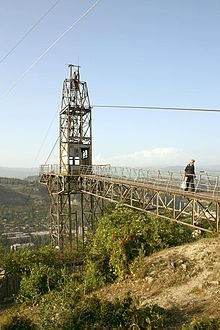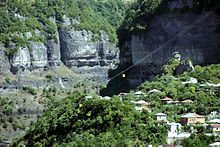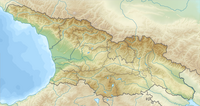Chiatura (ჭიათურა, English spelling Chiatura) is a small town in Imereti and capital of the administrative district of the same name (Raioni). Manganese ore is mined in the city and the city is particularly worth seeing for tourists because of the large number of cable cars that cope with local public transport.
background
Chiatura (Georgian ჭიათურა) - the name means literally translated: "A worm or none" and comes from the well-known Georgian author Akaki Tsereteli, who said this when looking at the winding streets - has 16,736 inhabitants and is located at the foot of the Caucasus on the Kwirila River 149 meters above sea level.
There are extensive manganese ore deposits near the city, which have been mined underground since 1877. Before the First World War, Chiatura was the largest manganese ore producer in the world. Its share in world volume was almost 40%, the share in world exports was over 50%. From 1879 almost all fields were in the hands of German companies, the majority of the exported manganese ore was processed in Germany until 1918. After the October Revolution, the mines were nationalized and were used to build up Russian and Georgian heavy industry. In Sestaponi Numerous smelters and blast furnaces were built to process the manganese ore. Today the high-quality deposits are almost exhausted, the state mine Chiaturmanganumi filed for bankruptcy in the 1990s and was sold to the Russian company EvrazHolding in 2004 for 12.5 million US dollars.
During the Russian Revolution in 1905, Chiatura was the only Bolshevik stronghold in the otherwise Menshevik-dominated Georgia. At that time, the miners worked 18-hour shifts and lived in the tunnels under inhumane conditions. On August 28, 1924, the city was the starting point of the August uprising in Georgia, the last major rebellion against the rule of the Bolsheviks in the southern Caucasus.
In 1992 the gas, water and electricity supply in Chiatura completely collapsed. A public power supply has only been available again since 2004, before the residents were dependent on private diesel generators. The gas and water supply network is now completely rotten, drinking water has to be brought in canisters from springs and a few wells in the city. Apartments, even in high-rise buildings, are heated with wood stoves. Due to the situation, as well as the loss of numerous jobs in mining after 1992, the population has almost halved from 30,000 to 16,000.
getting there

By plane
Closest airports are Kutaisi (90 km), Batumi (180 km) and Tbilisi (190 km)
By train
Chiatura is on the railway line Sestaponi-Punch scissors, there are two pairs of trains every day Kutaisi-I - Sestaponi - Chiatura - Satschere. The station 1 is a few hundred meters southeast of the city center.
Coming from Tbilisi you have to change trains in Sestaponi, although long waiting times are sometimes necessary here because of the timetable. It is therefore better to switch to one of the frequently traveling marshrutka in Sestaponi.
By bus
Minibuses run several times an hour between Chiatura and Sestaponi and Satschere. From Tbilisi you can take a minibus from Didube bus station to Chiatura (3 hours, 12 GEL).
The bus station is located above the city center on Chigladze Street 2 . Another small bus station for regional connections 3 is located in the city center right next to the triple cable car station.
In the street
Regional road შ 22 runs directly through Chiatura. Coming from Kutaisi drive to Sestaponi, take the bypass and turn left just before the bridge over the Kwirila, 40 km to Chiatura. Coming from Tbilisi or Gori, turn right in the village of Gomi, 10 km before Chaschuri and follow the road 70 km via Satschere to Chiatura.
Since the main route between Tbilisi and Kutaisi over the Rikoti Pass is heavily used and therefore very stressful to drive, it is also advisable to take the detour via the შ 22 on journeys between West and East Georgia and stop briefly in Chiatura. The approximately 1 1/2 hours longer driving time is rewarded with a well-developed road with almost no traffic.
mobility
The most important public transport in the city and at the same time the main attraction are 26 cable cars that meet at different cable car stations. They connect the city center in the valley with the residential areas, some of which are high on the rocks, and the numerous mine shafts. There are also over 50 cable cars for manganese mining. Giorgi Mumladze planned and built 24 cable cars for passenger and 50 for material transport. Most of the cable cars date from the 1950s and 1960s and almost all of them are still in operation, although they are temporarily closed for maintenance work. They are kept going by the talent for improvisation and personal devotion of the cable car staff against the poor budgetary situation. A modernization of the cable car network is being planned, but not yet in concrete terms. The fares for the cable cars vary between free and 50 Tetri. At the moment (2018) the central cable car station and the connected cable cars are being renovated. This means that these lifts are currently out of service. The smaller cable car station, with what are probably the two oldest cable cars, run regularly and are free of charge.
The 20 km long overland trolleybus route between Chiatura and Satschchere was discontinued in 2009.
Tourist Attractions

The city's greatest attraction is its numerous Cableways dar (see chapter "Mobility"), some of which lead steeply along rock faces and also offer great views of the city. Even those who do not dare to do the adventurous rides can photograph great cable car motifs from the ground. Particularly noteworthy examples of the 26 passenger and over 50 material ropeways are:
- The 4 Friedensbahn and cable car 25 (valley stations)(north of the city center), built in 1966, is the steepest railway in Chiatura and overcomes a gradient of 48 ° (111%).
- Cable car no. 25, the oldest cable car in the city, built in 1954. It has been operating in its original state without interruption for over 60 years.
- The triple cable car station 1 in the city center right next to the bus station is a special feature, as it is the valley station of three cable car lines.
Mine and industrial freaks will also get their money's worth when they take one of the cable cars (the "Friedensbahn" is ideal here) to one of the 2 Manganese ore mine and inspect the old mine railways and material ropeways there. The miners are very friendly and even allow you to come down the shaft if you ask nicely.
This is ideal for strolling City center with the pedestrian promenade on the Kwirila 3 the town hall is located there 4 as well as business buildings in the Stalinist-classicist style and a few coffee houses.
This is at the train station Tsereteli State Theater1 .
Just outside the city center, on the road to Sestaponi, there is an imposing one 6 World War Memorial.

The Mgwimewi Cathedral (10th to 11th century) 7 is located a little outside the city, about one kilometer after the end of the village on the road to Punch scissors.
In the Surroundings:
- Katskhis Sveti
- 8 Giorgi Tsereteli House-Museum, Chiatura district, Tskhrukveti village. Tel.: 995 595 201661, Email: [email protected]. In the family palace of the Zeretelis, the author's personal belongings are on display, such as clothing, manuscripts and furniture from the early 19th century.Open: Tue-Sun 10 a.m. - 6 p.m.Price: 1 GEL.
- 9 Siblings Japaridze House-Museum, Chiatura district, Khreiti village. Tel.: 995 595 201661, Email: [email protected]. On display are personal belongings of the Georgian family of mountaineers, such as souvenirs, photos as well as documents and publications on the history of mountaineering in Georgia.Open: Tue-Sun 10 a.m. - 6 p.m.Price: 1 GEL.
Katskhis Sveti
The 40 m high rock 10 Kats'chi pillar(კაცხის სვეტი, kac'xis svet'i) is located approx. 10 km west of the city, easy to see from the road to Sestaponi. At the top of the limestone monolith there is a small monastery that looks a bit on Meteora remembered in Greece.
Locals call the rock the "Pillar of Life" and symbolizes the "True Cross", a remnant of the cross on which Jesus Christ was crucified. The rock was first climbed and examined in 1944, more systematic research was carried out from 1999 to 2009. The ruins of the monastery high up on the rock were dated 9-10 Dated to the 16th century, the monastery existed until at least the 13th century. In the 1990s, religious activities began again on the rock, the monastery was reopened in 2009 with government funding and is now accessible via an iron ladder. There is also a newly built chapel at the foot of the rock.
The cliffs around the Kats'chi column are ideal for climbing (see chapter "activities").
activities

- Climb at the rock monastery Katskhis Sveti, Routes with levels of difficulty 5a - 7b.
- Mine tours are not officially possible, but if you ask nicely at a shaft, you may be shown around a little.
- The soccer club FC Chiatura has played in the highest Georgian league since 2004.
shop
- You won't find any large supermarkets in Chiatura.
- In the city center you will find numerous small shops that sell everything you need for life, from groceries to Chinese scrap.
- The small 1 Fruit and vegetable market is behind the bus station.
- 2 Bank of Georgia (Service Center 47), 16 Ninoshvili St.. Tel.: 995 227 953969. Open: Mon-Sat 10: 00-17: 30.
kitchen
Unfortunately there are practically no restaurants in Chiatura. In the city center on the Kwirila promenade there are some cafes that also serve snacks such as Khachapuri and co. sell, but whoever wants to go out for fine dining will not be happy in Chiatura.
nightlife
- 2 Akaki Tsereteli State Theater, 15 Chavchavadze Street. Tel.: 995 577 213524. Founded in 1894, current building built in 1949, currently directed by Andro Enukidze and Nana Tsereteli, mainly classical and modern plays by Georgian authors are shown.
- 3 Kinoteatri "Magaroeli", Kazbegi St. 2. Open: used seasonally.
Otherwise, the nightlife in Chiatura is practically non-existent and is limited to private parties or in summer to small groups of mostly men who sit around in the city center and in parks with beer bottles, home-made schnapps and cigarettes. As a tourist you are often invited to join the drink. Georgians have a high regard for guests and are extremely generous, even if they shouldn't have much themselves. On the one hand it can be very interesting to come into contact with locals, on the other hand it can also lead to a veritable high.
accommodation

The choice of accommodation in Chiatura is modest, two inexpensive options are listed by the Imereti tourist information office, so you shouldn't expect too much comfort:
- Hotel Mghvimevi (მღვიმევი), Mghvimevi St. 1 (მღვიმევის ქ. 1). Tel.: 995 599 759528. Price: 25 GEL p.p.
In the village of Sairkhe (district Punch scissors) (~ 20 km) there is a three-star hotel:
- 1 Hotel Sachkhere, Sairkhe village. Tel.: 995 598 998888, Email: [email protected]. Price: 50 GEL p.p.
The gorge at Katskhis Sveti Monastery is ideal for wild camping
There is more choice of accommodation of all kinds in Sestaponi (40 km) or Kutaisi (80 km).
In particular, the lack of restaurants and accommodations does not make it easy for potential tourists to travel to Chiatura, even though the city, which is economically so hard to hit due to the decline in mining, and is well worth seeing, would come in very handy with valuable income from moderate tourism. But the number of tourists as well as the domestic purchasing power are currently too low for such institutions to be able to establish themselves, and Georgia’s efforts to market national tourist attractions internationally are limited to churches, viticulture, beach and alpine holidays, which are not in Chiatura gives.
Learn

In Chiatura there is a faculty of Georgian Technical University4 .
Work
With high unemployment in the city, it is difficult or even impossible for foreigners to find a job unless they are specialists in mining.
security
- When it comes to crime, there is almost nothing to fear in Chiatura - as in the rest of the country.
- The extent to which the use of the cable cars is safe or the extent to which the safety-relevant facilities of the cable cars are maintained cannot be assessed as an outsider, but no major incidents have been documented in the recent past.
- Be careful when visiting pits and tunnels: the overhead lines of the mine railways hang just above the ground, sometimes at about head height - an electric shock can be fatal! In addition, the mines and some higher-lying residential areas are in close proximity to rock faces and abysses, which also harbors a great risk of falling.
health
- In Chiatura there are some pharmacies that stock the most important medicines (as well as baby food, diapers, etc.).
- The local hospital is located north of the city center on the hillside 1 .
- Nothing is known about German or English speaking doctors in the city.
- Anyone who becomes seriously ill should seek advice if possible Kutaisi or Tbilisi drive!
Practical advice
- There is no tourist information office in Chiatura.
- The residents are very friendly and helpful if you treat them with respect and friendliness; it is very helpful if you can break a few words in Georgian or Russian.
- In general, the people in Chiatura are very poor due to the high level of unemployment, even in domestic Georgian comparison. You should therefore refrain from showing your wealth (cash, expensive electronic devices, etc.) in order not to provoke envy or even criminal acts.
The post office 2 is located at 4 Chavchavadze Street, near the train station. The postcode of Chiatura is 5500.
trips
.jpeg/220px-კაცხის_სვეტი_(Denisi_Tsabadze_2010).jpeg)
- Katskhis Sveti (see chapter "Tourist Attractions")
- The neighboring district capital Punch scissors (approx. 16 km to the northeast)
- Chorvila village (Satschchere district), birthplace of w: Bidzina Ivanishvili. There is a magnificent summer residence of the multi-billionaire and former Georgian Prime Minister with its own zoo. The specialty of the place is that, in contrast to the rest of the country, practically all houses in the region have been completely renovated, which was financed by the private fortune of the businessman as a tribute to his home community.
- As a logical continuation of the collapsed mining town of Chiatura, an extended visit to the collapsed smelters and blast furnaces in Sestaponi where the manganese ore was once processed.
- Tkibuli - Another mining town near Chiatura (~ 30 km), where coal is mined to this day
literature
- Richard M. Levine: The Mineral Industry of Georgia, 1996, [1]
Web links
- Alan Taylor: Stalin's Rope Roads, The Atlantic Online, 8/20/2013 [2] - nice photo gallery of the cable cars.



